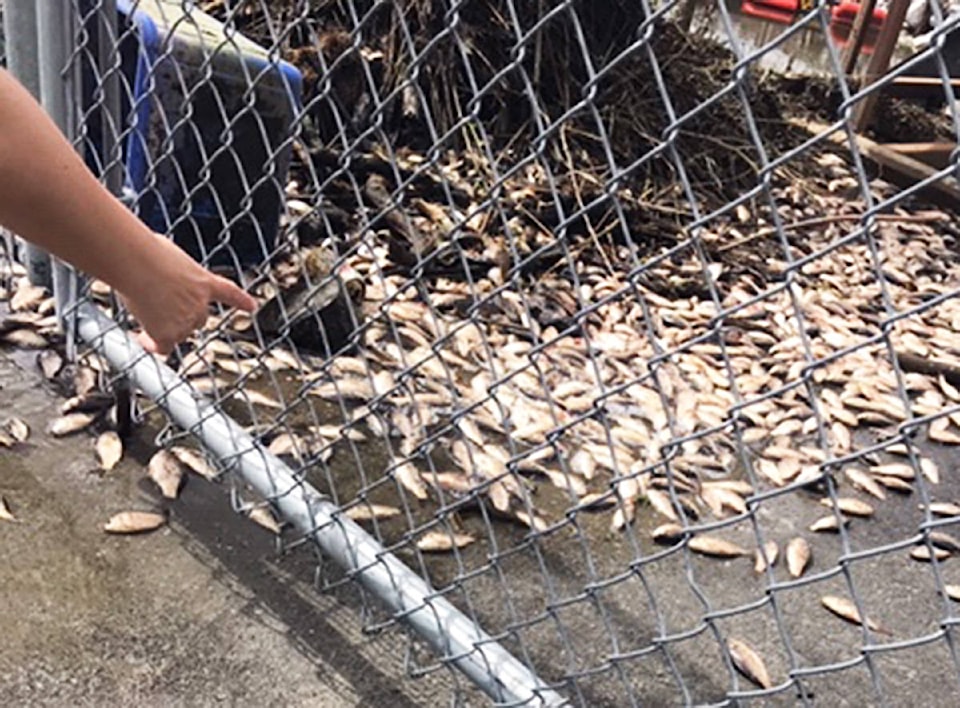“He was stepping on fish and scooping them up with a backhoe. I’d never seen anything so horrific. I’m still in shock.” – Lisa Hickman.
Lisa Hickman of Pitt Meadows and her friend jog the dike that runs westward along the South Alouette River from Neaves Road.
Just beyond Sharpe Road, they pass the McKecknie pump station, where Cranberry Slough meets the Alouette.
On April 24, it was the site of a fish kill.
“I couldn’t believe what I was looking at,” Hickman told me, “thousands of fish flopping around in the pump’s fenced enclosure on something like a conveyor belt. I was in tears. It was horrible. My friend said I shouldn’t do it, but I went through the gate and started scooping the fish into a bucket with my hands.”
A City of Pitt Meadows staff person was present.
City operations manager Randy Evans said the staff person was clearing the pump’s debris catching screen.
Hickman the city staffer said she couldn’t be inside the fence.
“I’m saving these fish,” Hickman said back, “and I’m not leaving here until you help me.”
She scooped the fish with her hands.
“It was an hour before he surrendered a broom and offered to help carry one bucket to the top of the hill.
Hickman didn’t. She carried 10 buckets of fish up a stairway, over the dike to the Alouette River “for three hours.”
Her friend, also crying, helped.
“We had to. We all need to step up for wildlife and the environment when we see something like this. Finally, I couldn’t do it. I fell over. I’m fit, but the pain was unbearable.”
The system’s designed to remove milfoil weed and parrot feather that clogs the pump, Evans told me later.
The screens, due to weed growth, are needed to prevent flooding, Evans added.
“If we didn’t have them, there would be flooding.”
He said the fish jump on the screens every year.
“We don’t know why.”
I asked him what is done with the fish?
“Typically, they go off with the debris to the landfill site,” he said.
Can fish get through to the Alouette?
“No,” said Evans.
I told him that those fish are part of an ecosystem, that they feed animals. I listed some I’d seen: osprey, eagles, mink, otters, owls, and heron. The Pitt Meadows “Natural Place” symbol eats them, too.
Evans said that could explain what happens to piles of fish not picked up until the following day.
“They were all gone,” he said.
In 2013, the city hired Scott Resources Services to inventory fish in Katzie Slough, which includes the Cranberry arm.
They trapped 11 species, including native stickleback and sculpin protected under provincial regulations, which read: “It is illegal to retain” these “at-risk fish”… “If you catch one accidentally, you must release it immediately.”
Coho and cutthroat trout are protected under the Federal Fisheries Act.
Because many species are breeding now, B.C. regulations require maintenance work in water with fish be done in August.
The Provincial Ministry of Forests, Lands, Natural Resources – Compliance and Enforcement Branch - has opened a file for Hickman, who has questions.
Does Pitt Meadows have an exemption under provincial laws like Wildlife Act, or Fish Protection Act to truck fish to the garbage dump, or work outside the safe window for maintenance?
Shouldn’t it be returning the fish caught accidentally to the water?
McKecknie pump isn’t fish friendly. Fish are ground up. Converting to a tide-sensitive-fish-friendly system that opens and closes with tides would guarantee safe water levels and safe passage of fish.
In 2010, Maple Ridge brought coho back this way at Spencer Creek.
Scott suggested salmonid stocks could increase with more water flow and plant cover. It’s Premier John Horgan’s goal, too. In June 2018, he established the B.C. Wild Salmon Policy to sustain wild salmon.
Fish friendly sloughs would help a lot.
READ ALSO: A flawed made-in-B.C.-plan for wild salmon.
Hickman was told a ministry officer assigned her file would call her right away. She requested they call me, too. They agreed. So far, nobody has.
Could Pitt Meadows save fish from dying?
“It’s feasible,” Evans told me. “We’d have to design something to let them move, a channel back into the water. They’d just jump back on the screen, though. Perhaps a fish ladder over the dike. It would be a decision of the city engineering and operations departments. They could go back to the design of the system.”
I wonder if it is possible to run the pumps for shorter periods when needed instead of 24 hours a day to save fish life?
Jack Emberly is a retired teacher, local
author and environmentalist.
